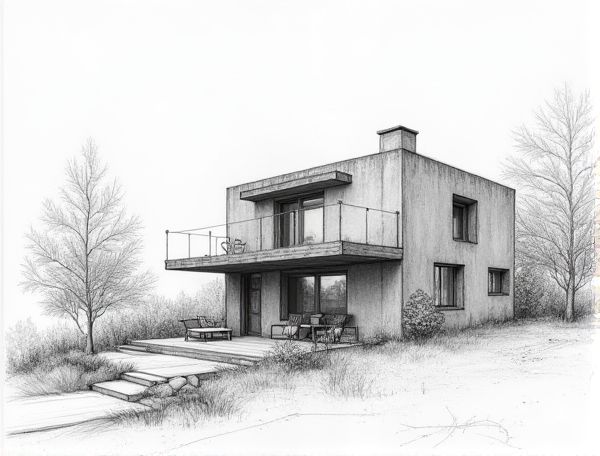
Photo illustration: Sustainable home design with hempcrete insulation
Hempcrete insulation offers a sustainable home design solution by providing excellent thermal regulation, moisture control, and carbon sequestration, reducing Your environmental footprint while enhancing indoor comfort. Explore the full article to discover how hempcrete can transform Your eco-friendly building projects.
Introduction to Sustainable Home Design
Sustainable home design emphasizes energy-efficient building materials, passive solar heating, and eco-friendly insulation to minimize environmental impact. Incorporating renewable energy sources like solar panels and rainwater harvesting systems enhances resource conservation and reduces utility costs. Designing with sustainability principles promotes healthier indoor air quality and long-term durability while supporting global climate goals.
What is Hempcrete Insulation?
Hempcrete insulation is a sustainable building material made from the inner woody core of the hemp plant mixed with a lime-based binder, offering excellent thermal and acoustic properties. It naturally regulates humidity and improves indoor air quality by preventing mold growth and providing breathable walls. When you choose hempcrete insulation, you enhance your home's energy efficiency and contribute to an eco-friendly living environment.
Environmental Benefits of Hempcrete
Hempcrete offers exceptional environmental benefits by providing a carbon-negative building material that actively absorbs CO2 throughout its lifecycle. Its natural insulation properties improve your home's energy efficiency, reducing heating and cooling costs while minimizing reliance on fossil fuels. Moreover, hempcrete is biodegradable and non-toxic, promoting healthier indoor air quality and sustainable living environments.
Thermal Performance of Hempcrete in Homes
Hempcrete offers exceptional thermal performance with an R-value ranging from 2.4 to 3.0 per inch, providing excellent insulation and maintaining stable indoor temperatures year-round. Its lightweight, breathable structure reduces heat loss and moisture buildup, improving energy efficiency and indoor air quality in homes.
Moisture Regulation and Indoor Air Quality
Effective moisture regulation in home design prevents mold growth and structural damage by controlling humidity levels through proper ventilation and use of vapor barriers. Indoor air quality improves significantly with the integration of air purifiers, low-VOC materials, and consistent airflow management. Together, these strategies create a healthier living environment by reducing allergens, pollutants, and moisture-related issues.
Hempcrete Construction Methods
Hempcrete construction methods utilize a bio-composite material made from hemp hurds and lime, offering exceptional insulation and breathability for energy-efficient homes. This sustainable approach reduces carbon footprint while providing natural moisture regulation and durability. By incorporating hempcrete into your home design, you enhance indoor air quality and contribute to environmentally responsible building practices.
Cost Considerations and Longevity
Selecting materials with high durability, such as hardwood flooring or stone countertops, reduces long-term maintenance and replacement costs in home design. Investing in energy-efficient windows and insulation lowers utility bills and enhances the lifespan of the home's structure. Balancing upfront expenses with the potential for reduced future repairs ensures cost-effective and sustainable home design solutions.
Design Flexibility with Hempcrete
Hempcrete offers exceptional design flexibility due to its lightweight and moldable properties, allowing architects to create innovative shapes and structures without compromising durability. Its ability to blend with various insulation materials enhances thermal performance while supporting sustainable building practices.
Challenges and Limitations of Hempcrete
Hempcrete offers excellent insulation and sustainability benefits but presents challenges such as low structural load-bearing capacity, requiring additional framing materials for support. Its moisture retention properties can lead to longer drying times and potential mold issues in poorly ventilated environments.
Future Trends in Sustainable Hempcrete Homes
Future trends in sustainable hempcrete homes emphasize enhanced thermal insulation and carbon-negative construction materials, reducing overall environmental impact. Integration of smart home technologies enables efficient energy management and improved indoor air quality within hempcrete structures. Advancements in hemp cultivation and processing are driving cost-effective, scalable production, making hempcrete a viable option for eco-friendly residential design worldwide.
 homedesy.com
homedesy.com